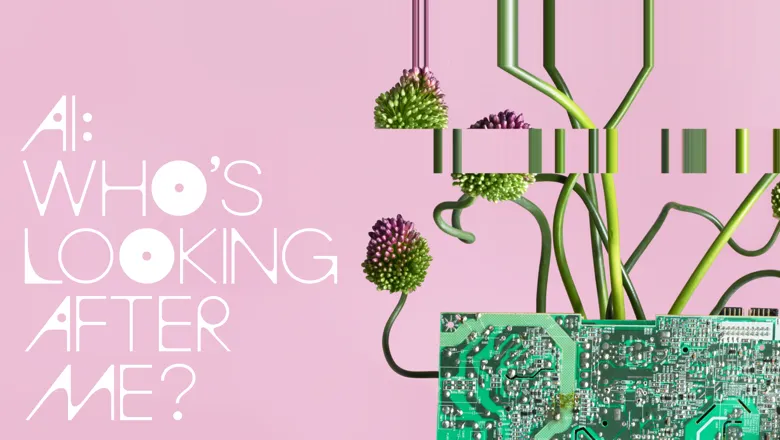King’s AI research is broad, from health, science and engineering to humanities and social sciences. This exhibition which brings together King’s researchers, local communities, patients, leading artists and technologists, contributes to our institutional priorities of fostering knowledge exchange, facilitating public and community engagement, and ensuring AI research and innovation is used for good.
Professor Bashir M. Al-Hashimi, Vice President (Research & Innovation) at King's College London
26 April 2023
New season at Science Gallery London explores the ethics of AI
King’s flagship public gallery Science Gallery London announces ‘AI: Who’s Looking After Me?’, a new major exhibition and public events programme exploring artificial intelligence and its impact on our lives.

Science Gallery London today announces the 2023 season, ‘AI: Who’s Looking After Me?’. The free exhibition and events programme, running from 21 June 2023 - 20 January 2024, will explore who holds the power, who distributes the benefits, and who bears the burden of existing AI systems, asking the question, Who’s Looking After Me?
Presented with FutureEverything, and characteristic of Science Gallery London’s approach to developing cultural projects, the season has emerged from unlikely and inventive collaborations between people who might not otherwise have worked together, including artists, technologists, students and young adults in Lambeth and Southwark, engineers, computer scientists, sociologists, patient groups, medical professionals, and many others. The exhibition has been created with sector-leading researchers from seven departments across King’s College London, as part of 12 artistic collaborations.
'So many of our conversations about AI treat it as this distant, sleek, even magical thing; our attentions are daily directed towards the latest product or scandal,' said Siddharth Khajuria, Director of Science Gallery London. 'In all this hype and marketing, I think we’re losing sight of the human — both in how AI technologies are made, and the many ways they’re already woven into our lives. To be able to grasp and shape the course of AI’s journey, we need to grapple with its messy, multiple realities and I hope this exhibition can be an invitation to do that. It’s characteristic of what we’re trying to do as a gallery, to nurture unlikely, inventive collaborations and dialogues and be a home for the cultural work that emerges from them.'
By bringing together different disciplines and life experiences, the works invite visitors to reflect on what it means to entrust care to autonomous machines. Artists including Air Giants, Blast Theory, Fast Familiar and James Bridle reveal the surprising places in which AI technology is already embedded in our world and raise questions around the powerful ways AI may influence our futures.
'Artificial intelligence technologies have been recomposing our world through new taxonomies, narratives and aesthetics, creating a monocultural view of our society', said Irini Papadimitriou, Creative Director of FutureEverything, the arts organisation collaborating with Science Gallery London on the season. 'At FutureEverything, we believe that art and cross disciplinary exchange can help us imagine better, collective stories about technology, moving away from the hype and corporate narratives. The season provides a much-needed platform for not only sharing different perspectives, but also, for enabling collaboration and discourse.'
Jennifer Wong, Head of Programming at Science Gallery London added, 'This season invites you to dive into the opaque and murky workings of AI to explore what ethical and equitable human-AI systems might actually look and feel like. Who owns these systems and what are they for? Who decides what to optimize and who benefits? And how can we more responsibly harness the power of AI for the good of the many rather than the few? We want the exhibition and events programme to grow critical thinking and exchange between young audiences, artists and academic researchers, so that people gain a greater sense of what AI is and how they can exercise their own agency in relation to these technologies.'
‘AI: Who’s Looking After Me?’ exhibited works include:
- Cat Royale is the futurist utopia where cats are watched over lovingly by an AI robot arm, tending to their every need. The film and installation documenting cats’ experiences with an AI caregiver probe the future impact of new technologies on animal care... and the trade-offs involved. The work from internationally renowned artist collective Blast Theory, currently cultural ambassadors for the Trustworthy Autonomous Systems Hub, will be accompanied by live research from author and computer scientist Dr Kate Devlin, King’s Department of Digital Humanities.
- Autonomous Trap 001 from acclaimed artist and technologist James Bridle is a playful experiment in making meaningful partnerships with machine intelligence. The artist wrote his own software, built neural networks and rigged up cameras to build his own self-driving car, showing the possibility and power of shaping our own relationship with technology. His work seeks to find common ground between human and machine ways of comprehending the world, whilst resisting corporate power.
- Ten years ago, Jeff Bezos shared a vision for the world where every home had an Alexa voice assistant. In reality, the environmentally extractive nature of manufacturing these AI technologies, the inability to recycle or repair them, and the lack of transparency around their function leads to questions around their presence in our lives. In the eerie and immersive installation Newly Forgotten Technologies, sound artist Wesley Goatley presents a cautionary tale from an undefined near future, where voice assistants are defunct.
- In Sprout, visitors will meet the giant, inflatable, huggable robot that responds to human behaviour. Rooted in research led by Dr Oya Celiktutan, Head of the Social AI & Robotics Lab, King’s Department of Engineering in collaboration with creative robotics studio Air Giants (currently in residence in the department) and King’s students Jeffrey Chong, Theodore Lamarche and Bowen Liu, Vine incorporates innovative soft robotics and explores how we might develop the next generation of robots that can learn by interacting with humans. The research uses the theory of Proxemics - the study how humans use space as a form of non-verbal communication - to explore how motion, distance and space might facilitate effective communication between humans and robots.
- Would training a machine on everything the internet knows about love result in unparalleled romantic success? Would you allow data to be decision-maker on all aspects of your romantic life? Looking for Love is part modern-day Tamagotchi, part interactive fiction and part experiment from Fast Familiar, the award-winning studio rooted in audience-centric experiences and the digital world.
- In What is Essence? visitors are invited to consider the very essence of seeing and express their own unique perspective of the world. Using a diverse range of AI-generated ‘artistic’ depictions of natural objects, the exhibit pushes the limits of current AI capabilities, exposing the ever-closing gap between human intelligence and AI and examining the nature of our own perceptive abilities. The work is a collaboration between PhD researcher Munkhtulga Battogtokh from King’s Department of Informatics and visual artist Alice White.
- Who are the workers behind the vast datasets machines learn from? The Future is Here! from visual artist Mimi Ọnụọha teases out myth from reality in the hidden, globally distributed human labour market that enables AI systems to function. Without crowdsourced tagging, labelling, and annotation work, the artist shows that bulk of machine learning as it unfolds today would simply not be possible.
- Between The Lines from visual artist Sarah Selby, in partnership with Cari Hyde-Vaamonde, Visiting Lecturer at King’s Law School and Turing Fellow, highlights the power of algorithms within the UK immigration and justice systems, and the loss of the individual within these emerging processes. As human experiences are increasingly transformed into statistical ratings by AI and automated decision-making, this installation seeks to reintegrate the lived experiences of the individuals impacted. Created in collaboration with Beyond Detention (an organisation supporting people detained at Yarl’s Wood detention centre) and Twist Bioscience.
- How Loud is Too Loud? considers how AI mediates access to the sonic world from multidisciplinary artist Seo Hye Lee in collaboration with Irumee Pai from King’s School of Biomedical Engineering & Imaging Sciences. Drawing on her experience of using a cochlear implant, the artist explores the way in which AI is intertwined with her physical self in a way not previously possible, through sonic sculpture and textile work.
- Heartifical Intelligence is an immersive installation investigating the roles that technology and community each play in the healthcare journey of young heart patients. The piece was created in collaboration between TripleDotMakers, 9 young people who have congenital heart conditions and their siblings from the Evelina Children’s Heart Organisation (ECHO), and researchers at Wellcome/EPSRC Centre for Medical Engineering. Combining projection mapping, audio and sensors, the installations will pulse in sync to the heartbeats of the visitors while the audio piece explores themes including trust towards artificial intelligence in healthcare.
- Does AI Care? explores how novel AI tools could shape cancer care from the perspective of patients. Led by artist Sofie Layton, the collaboration brought together 8 young adults with experience of living with cancer and 3 researchers from the Wellcome/EPSRC Centre for Medical Engineering working at the cutting edge of AI applications in medical imaging, radiotherapy, and surgery. Through creative writing and making exercises, the group explored the project concepts together. The resulting audio piece and accompanying textile installation distils their conversations to reflect on the nature of AI, cancer and care and to consider how technological developments may change how patients are cared for.
- Clinical researchers from King’s Centre for Medical Engineering will conduct live research in the gallery, inviting visitors to offer their perspectives on the use of AI in healthcare, with collected responses informing future research.
- Each Saturday throughout the season, Sentient Beings will invite visitors to question their relationship to security and privacy within the digital landscape of AI assistants. Featuring an immersive soundscape, the work sees artist Salomé Bazin collaborate with Dr Mark Cote from King’s Department for Digital Humanities, and Jose Such and William Seymour from the Department of Informatics.
- A dedicated space within the exhibition will feature a range of interactive tools, games and publications from artists, writers, researchers and designers including Mimi Ọnụọha, Lily McCraith and Soul Miles, Superrr Lab, Proboscis and Mozilla Festival.
If only we could train AI to remind us that humans already have the potential imagination and resources to make the world fairer, easier and safer for all! In the meantime, Science Gallery London’s new season helps us to understand how far these technologies are already informing every aspect of our lives - inevitably reflecting the contradictions of human behaviour - and inspires us through stories of participatory research and decision making to recognise the positive potential for multiple forms of non-human intelligence.
Beatrice Pembroke, Executive Director, King's Culture
About Science Gallery London
Science Gallery London is King’s College London flagship public space. Located on Guy’s Campus at London Bridge, it has a mission to grow new ideas across art, science and health, through a programme of exhibitions, displays, gatherings and workshops – each developed through conversation and collaboration between artists, researchers and young people.
"I am looking forward to Science Gallery London’s exhibition, as it promises to spark important conversations about our understanding of the impact of AI on many distinct aspects of our world, informed by research from across King’s,”, said Professor Michael Luck, Director of King's Institute for Artificial Intelligence. “With the increasing adoption of AI in our lives, we need deep knowledge of the social and ethical implications of AI and how to navigate them – something to which this season will make a timely contribution."
To find out more, visit london.sciencegallery.com/
Visitor Information
AI: Who's Looking After Me?
Dates: 21 June 2023 – 20 January 2024
Summer opening times: Wednesday - Saturday, 11:00 – 18:00
Address: Great Maze Pond, London, SE1 9GU
Free entry
GET INVOLVED: To stay up to day with future exhibitions and events from King's Culture, sign up to the mailing list.
In this story
Related departments
- King’s Culture
- Department of Digital Humanities
- Department of Engineering
- Department of Informatics
- Department of Philosophy
- Centre for Robotics Research
- King’s Institute for Artificial Intelligence
- Wellcome EPSRC Centre for Medical Engineering
- School of Biomedical Engineering & Imaging Sciences
- The Dickson Poon School of Law
- Faculty of Arts & Humanities
- Faculty of Life Sciences & Medicine
- Faculty of Natural, Mathematical & Engineering Sciences
- King’s & London
- Digital Futures Institute




